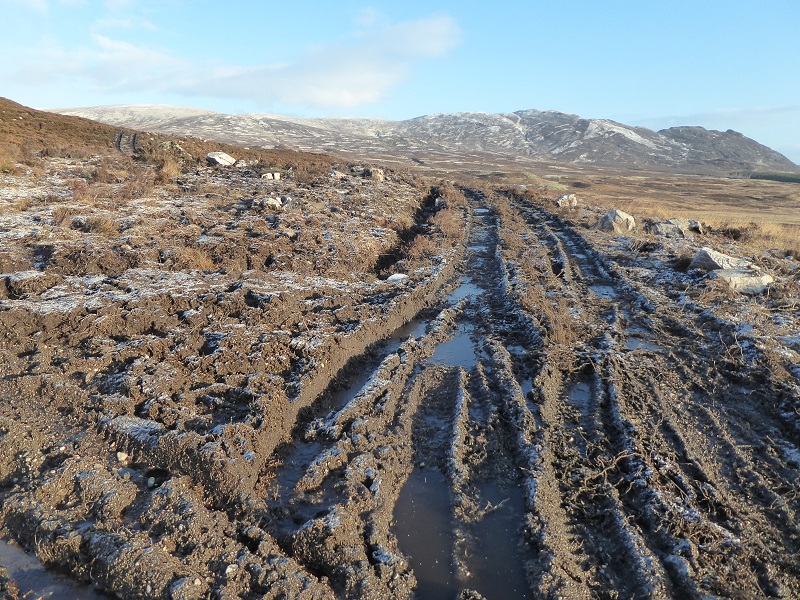
Earlier this year, the owner of the Pitmain estate, who appears to be Abdul Majid Jafar, bought the Glen Banchor and Strone Estate behind Newtonmore. I say “appears” because the information on Pitmain Estate Ltd at Companies House fails to declare who has significant control over the company.
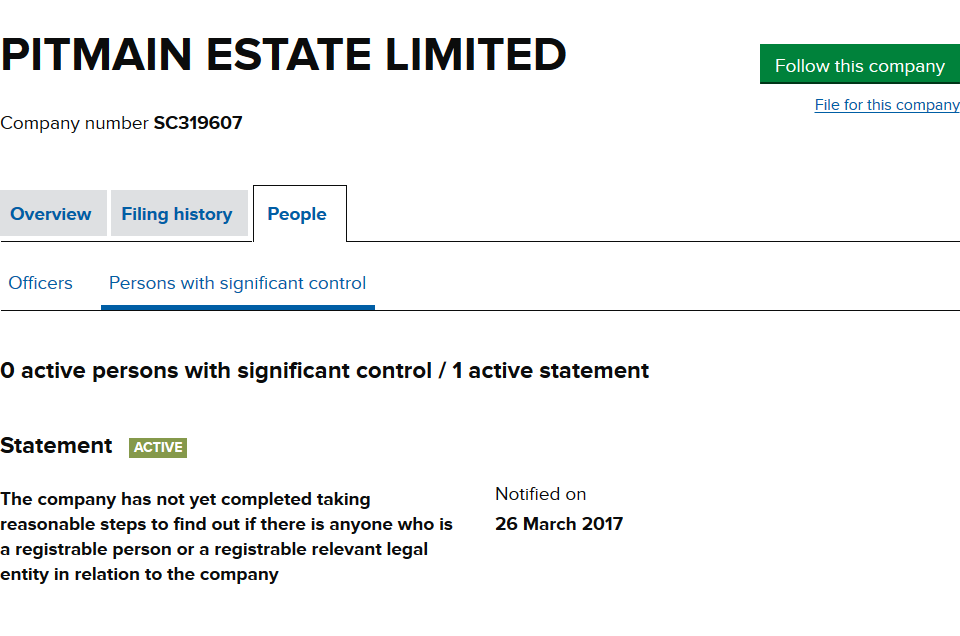
While Abdul Majid Jafar resigned as a Director in June 2015, to be replaced by an Indian Accountant also based in the United Arab Emirates, it appears he is still the owner. Its not only our landownership system which is opaque, our company system is too and there is abundant evidence for this in our National Parks. Abdul Majid Jafar’s family run Crescent Petroleum, the Middle East’s oldest private oil and gas company, so not short of a bob or too and well able to afford to do things properly if he so wished.
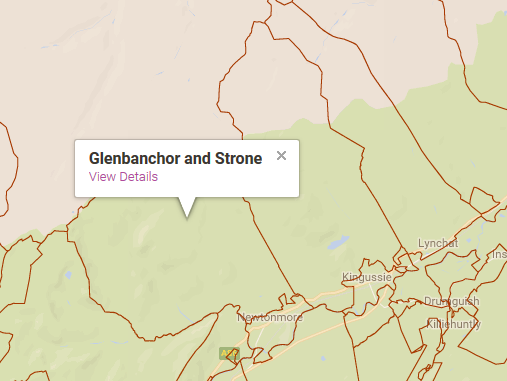
The previous owners of the Glen Banchor and Strone estate were the Lindt Family, of chocolate fame. They appear to have managed the estate for purely private pleasure (for example the internet has stories about how you could not pay to stalk there). This had its disadvantages, in that deer numbers were very high, but otherwise estate management appears to have been low key and unintensive. That appears to have changed since Pitmain took over, with significant consequences for land-management. This post will consider the new track works in Glen Banchor.
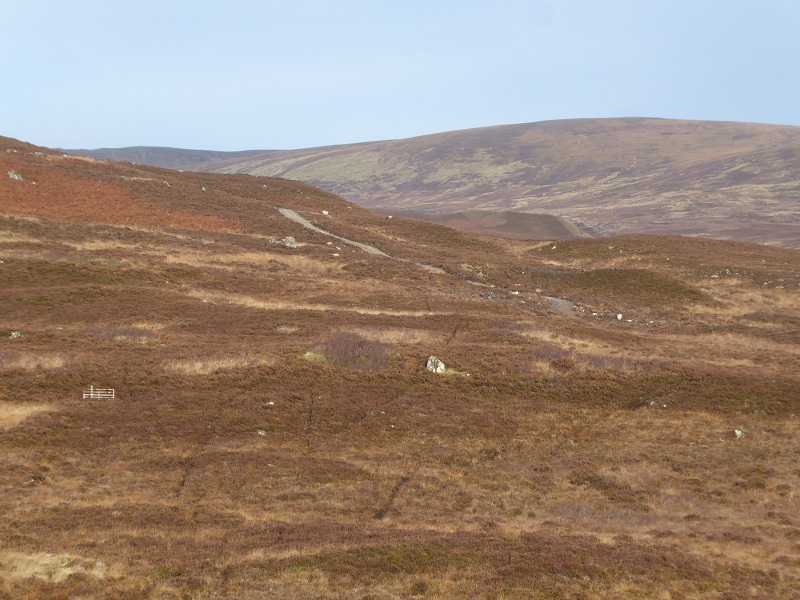
The boggy moorland where the road bends west into Glen Banchor (GR 702998) and lower slopes of Creag an Loin have long been used for sheep dog trials and there was a rough track along the fabulous esker – a deposit laid down by the glacier – that snakes across the moor. This then led up the slopes to a sheep holding pen. Unfortunately I don’t have photos of the old track (photos gratefully received!), so you can compare then and now, but it was little more than two wheel ruts and much used by walkers.
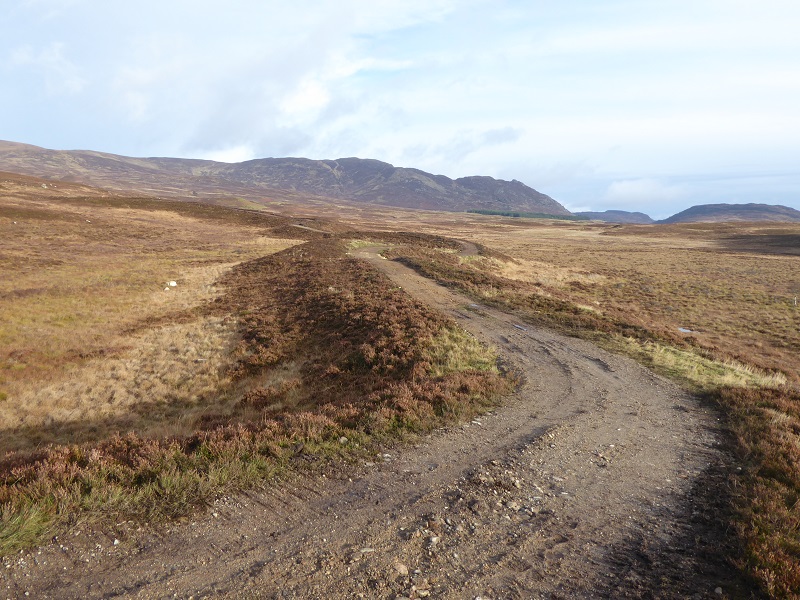
Under the Prior Notification system, any changes to existing agricultural or forestry tracks which increase their footprint or new ones should be notified to the planning authority (see Scottish Govt statutory guidance Page 11 onwards). There is no sign on either the Highland Council or Cairngorms National Park Authority planning portals that this has been done at Glen Banchor (I have written to the CNPA to double check and report the track works).
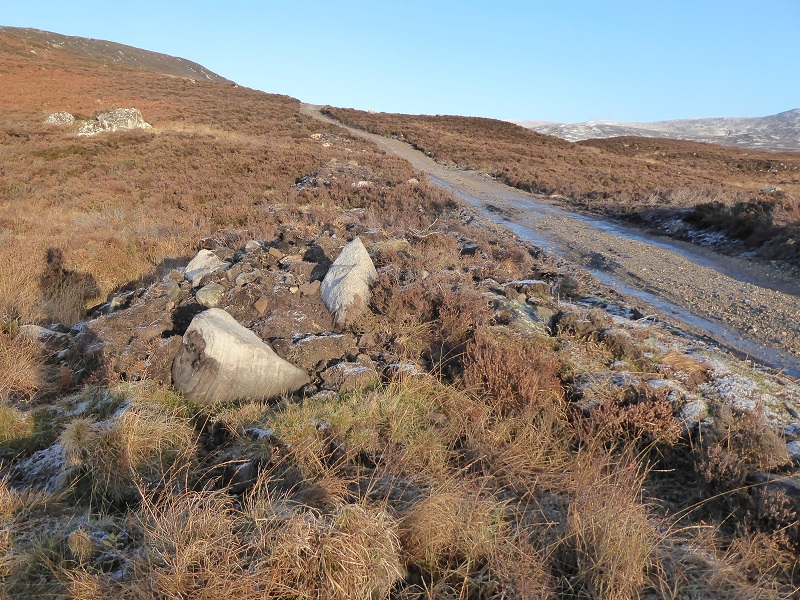
While full planning permission is not needed for agricultural tracks, the point of the Prior Notification system is it is “an important tool in preventing inappropriate construction of private ways” (Government Guidance). In this case there are plenty of signs of inappropriate construction (including above) which are not fitting for a National Park and do not meet SNH’s Best Practice Guidance on hill track construction.
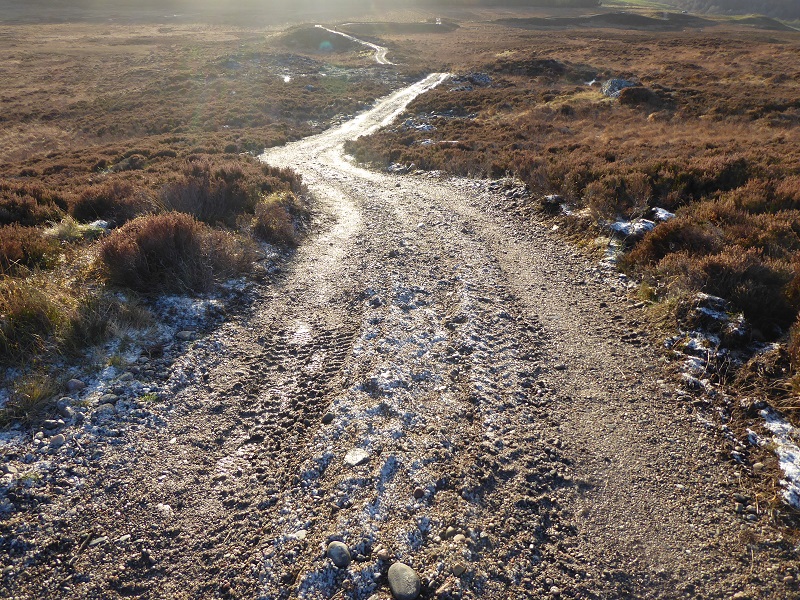 The upper section of the track is too steep and already eroding away, not helped by the lack of vegetation down the middle and an absence of drainage bars which means water runs straight down the line of the track.
The upper section of the track is too steep and already eroding away, not helped by the lack of vegetation down the middle and an absence of drainage bars which means water runs straight down the line of the track.

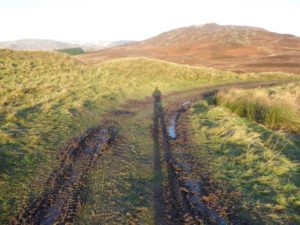
Since I learned about the track I have been twice, first time to have a quick look and then last Saturday when I walked along the track and beyond. While it has been very wet, the two photos show there has been a considerable deterioration in the track over the intervening 10 days and much of it has been churned into a quagmire.
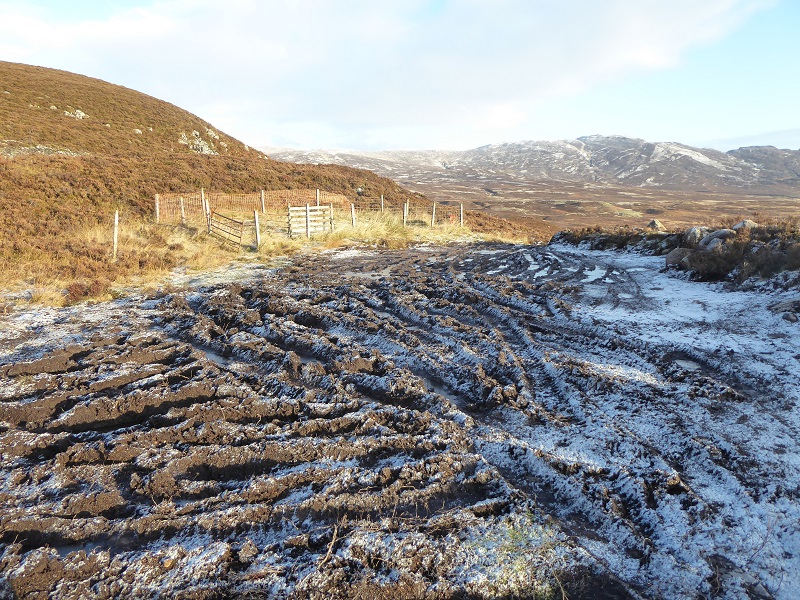
The problem is even worse at the top of the old section of track. I don’t think this mess has been created by sheep dog trials, the problem is the old land rover track is now being used for other estate management purposes and far more intensively than previously. It links to a new estate management track (see top photo) which has been created without any planning permission.
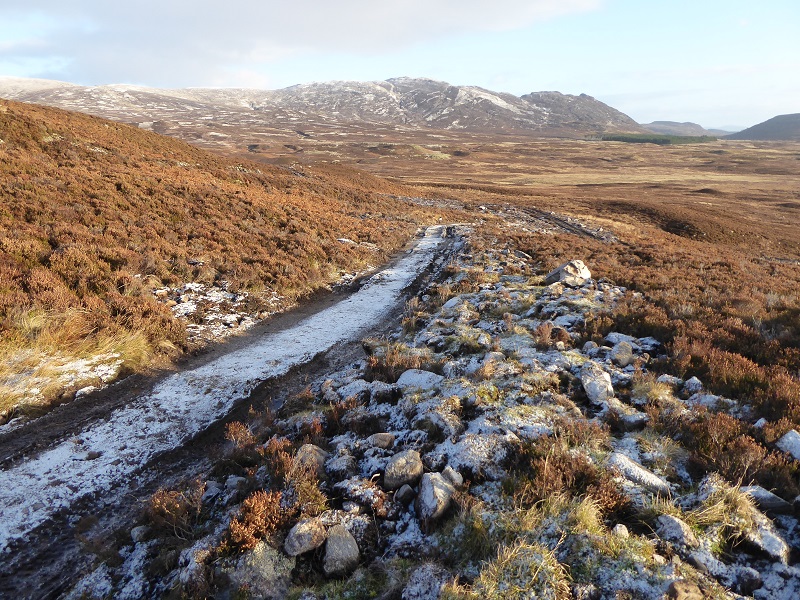
The new track leads to another turning circle and borrow pit:
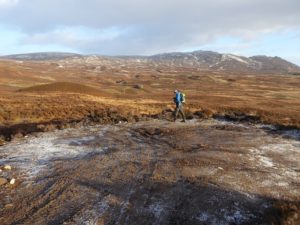
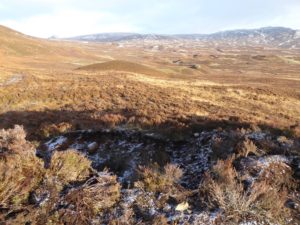
While the newly constructed track, which comes under planning law, ends at the turning circle beyond is an ATV track, if the quagmire created can be described as a track:
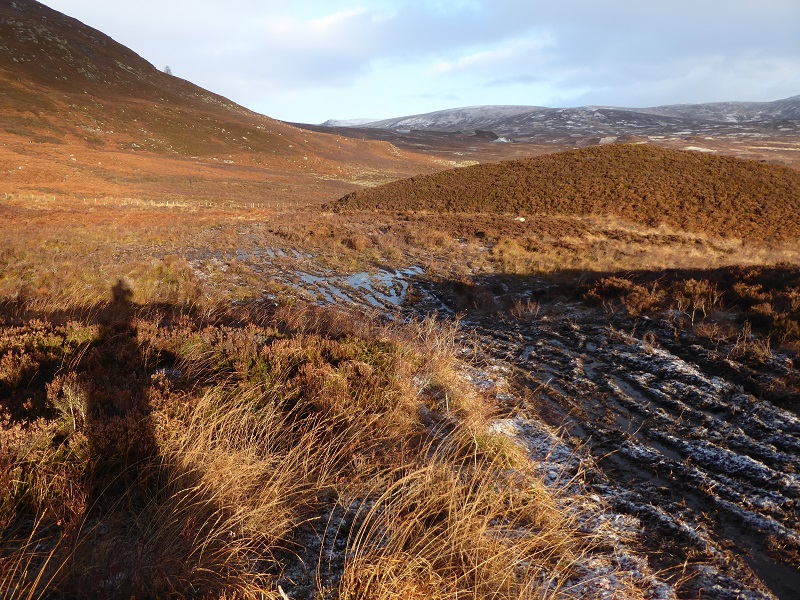
Behind the moraine on the right, the ATV track forks, one part linking to constructed tracks on the Strone part of the estate, the other heading up the hillside to a feeding station:
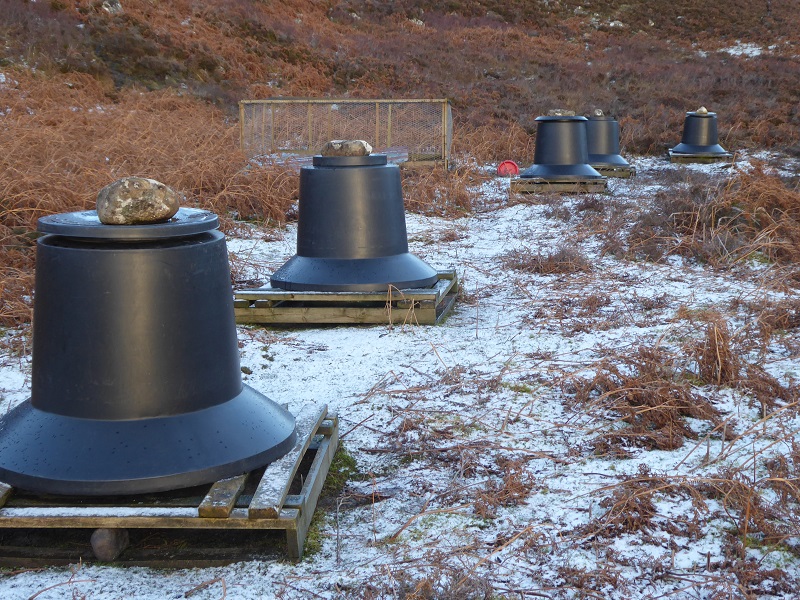
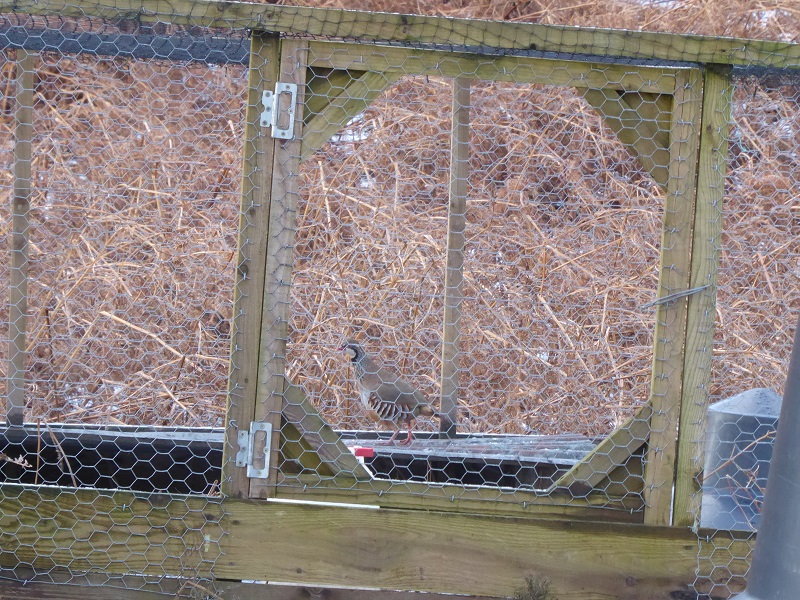
In terms of planning law, all this is important. The new section of track is clearly for game management purposes and therefore does not come under the Prior Notification System. Full planning permission was required, it has not been applied for and therefore this is yet another case of disregard of the planning system within our National Parks by landowners. The ATV eroded track beyond, however, because it has not been constructed falls totally outwith the planning system.
What needs to happen
While I understand (from an update they provided) that the CNPA are still working on the enforcement action they have agreed against the Cluny Estate for unlawful track on Creag an Leth Choin (see here), the basic problem the CNPA faces is that until they have taken effective enforcement action, landowners won’t see planning law as being important. Generally landowners see themselves as having the right to manage land as they wish and not as custodians for it, even in the National Park. The result has been that unlawful tracks continue to proliferate across the National Park. The CNPA needs to be seen to take action (just as East Ayrshire has recently done for breach of planning conditions at a windfarm).
Determined and rapid enforcement action would I believe, make a great difference. This track, being so recent, would be a good place to start. In addition, while I appreciate the Prior Notification system is very weak and not fit for purpose, the creation of an unlawful track linked to an “upgrade” of an existing track, should make it easier for the CNPA to argue that the “upgrade” of the existing track is more than that and not fit for purpose.
However, at present the CNPA has NO powers to address ATV created tracks, such as the featured here leading from the second turning circle to the feeding station. While SNH has powers to control ATV use on protected sites, only the western half of the Glen Banchor and Strone estate is designated as a Site of Special Scientific Interest, so there are at present no controls in this part of the National Park. In my view this has to change. I would like to see all ATV use on the open hill in National Parks being subject to consent through farm/estate management plans. The CNPA could do this through the creation of byelaws for conservation purposes.
This leads to the wider issue of estate management and landownership. On the landownership side, no additional checks are required before someone buys a large area of land in a National Park, either to establish whether they are fit to manage the land or what their intentions might be. While the Gynack hydro schemes on the Pitmain Estate are in many ways exemplary (see here) , step beyond them and the tracks further up the hill are a disgrace to the National Park:
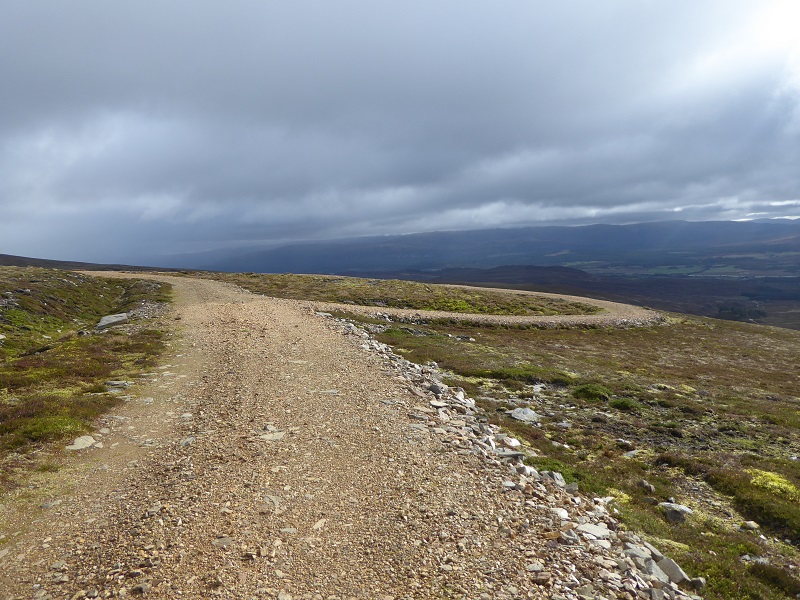
I have always wondered why an estate can do one thing well and another so badly. However, it appears from other new track works above Strone (which I will cover in a further post) that the estate is importing and applying its poor practice standards to Glen Banchor. While the CNPA has tried to encourage estates to produce management statements for their land, neither Pitmain or Glen Banchor have done so. The CNPA is therefore left in a position that when a new landowner takes over an estate, it has no idea what that landowner is planning to do in terms of estate management. That cannot be right in a National Park.
What is clear from the new Glen Banchor track is that the new owners are wanting to produce more game for shooting on the estate – hence the feeding station for Red Legged Partridge. This has implications beyond hill tracks and how they are designed. The Red Legged Partridge, which is of Mediterranean origin, does best in the wild on dry sandy soils and so, in the wild, is normally found on agricultural land. Increasingly though it appears to be being bred on moorland within the National Park. This requires intensive game managements methods akin to farming. On moorland, however, it is very exposed to predators, especially at feeding stations such as that featured here, and would provide the perfect food for hen harriers if they had not been persecuted close to extinction. With feeding stations like this, we should expect the number of hen harriers to increase significantly. Will that happen?
Leaving aside wider ecological consideration, feeding stations in our National Parks should only be allowed if estates can prove they are committed to protecting raptors. In this case, it would be in the public interest if that the Pitmain/Glen Banchor Estate were to clarify whether they are committed to this and whether clear instructions have been issued to staff telling them that if most of the Red Legged Partridge at the feeding station get predated by raptors that that is fine by the owners. It would be good if the CNPA, which states it is committed to improving grouse moor management, started to ask the estate these questions and to make the responses public.
Many thanks, Nick. Very well said; an excellent, though somewhat depressing, post.
FYI an interesting article on Jaffar is here http://www.thenational.scot/news/14904367.Landowner_linked_to_human_rights_abuses/ “Majid Jaffar, chief executive of Crescent Petroleum, which allegedly made much of its money through “close association” with Saddam Hussein”. The Global Justice report referred to is here http://www.globaljustice.org.uk/sites/default/files/scottish_landowners_case_studies_.pdf with more links embedded in it providing background on Jaffer.
This is really interesting Andrew – thanks very much. I guess what I take from this is that while in terms of the National Park there are no controls over whether a private owner is fit to manage the land according to National Park objectives, there is a much wider issue about whether people are fit to own land and how we control their activities. In a sense this demonstrates that issues in our National Parks are microcosms of the issues which face society, whether in Scotland, British Isles or wider than that.
Indeed… I note that the Scottish Government has initiated some research into how large land ownership is treated in other countries… Clearly the situation in Scotland is quite extreme, with a large part of Scotland in the hands of a very small number of people/private entities. I don’t see how this can’t be linked to national parks.
I have walked along this track many times, and was saddened to see the scars that had been left when I was there over Christmas. Unfortunately I don’t have any good photos of the previous state, but this photo on geograph shows the state of the track in summer 2007. http://www.geograph.org.uk/photo/529793 I think it remained in a similar state until the recent “improvement” works
Great photo, thankyou, I have forwarded to the National Park Authority
I have been working on the history of Glen Banchor for many years. This is extremely worrying for the future, though sadly not surprising. Unfortunately, heritage issues rank very low with the CNPA compared to economic developments. But this glen is crying out for historical interpretation for visitors – a microcosm of Highland history in terms of economy and depopulation, including a very well documented clearance site.